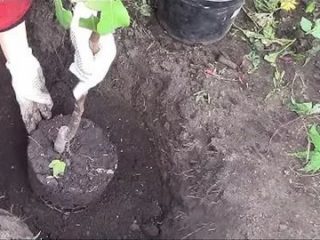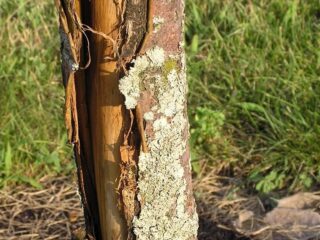Content
- 1 Is it possible and why to spray apple trees with iron sulfate?
- 2 Advantages and disadvantages
- 3 When to treat apple trees with iron sulfate
- 4 What solution of iron sulfate is needed for an apple tree?
- 5 How to dilute iron sulfate for treating apple trees
- 6 How to treat apple trees with iron sulfate
- 7 Feeding apple trees with iron sulfate
- 8 Precautionary measures
- 9 Compatibility with other drugs
- 10 Conclusion
Iron sulfate is used for apple trees in the spring for preventive purposes. Treatments begin at the end of March, before the buds swell. Usually a fairly concentrated solution of 2-3% is used. The basic rules of use, dosage and processing time are described in the article.
Is it possible and why to spray apple trees with iron sulfate?
Iron sulfate is a powder with small greenish-blue (turquoise) crystals. Chemically it is ferrous sulfate FeSO4 – inorganic salt, soluble in water. It destroys bacteria, fungi, and pests, therefore it is both a fungicide and an insecticide.
The drug is used for the prevention and treatment of diseases, as well as the destruction of apple tree pests:
- gray rot;
- scab;
- powdery mildew;
- coccomycosis;
- different types of spotting;
- lichens, mosses;
- crawling insects.
Advantages and disadvantages
Iron sulfate has quite a few benefits.

The drug is affordable and quite effective for prevention and treatment
Pros:
- has a wide spectrum of action;
- economical consumption;
- It is enough to carry out only 2 treatments per season;
- easily dissolves in water;
- can be used as a fertilizer (replenishes iron deficiency in the soil);
- non-toxic to humans and bees.
Minuses:
- oxidizes quickly in air;
- the period of protective action is no more than 2 weeks;
- absorbs moisture well, so it should be stored in a well-sealed container;
- may cause leaf burn if the solution concentration exceeds 1%;
- there are restrictions on compatibility with other drugs.
When to treat apple trees with iron sulfate
Spraying is usually carried out twice - at the beginning and at the end of the season. It is necessary to spray apple trees with iron sulfate in the spring even before the sap flows and the buds begin to swell. In this case, it is desirable that the temperature on the day of treatment be positive and be at least 4-5 degrees. In the middle zone this period occurs at the end of March, in the south - at the beginning of the month. In the Urals, Siberia, and northern regions - at the beginning of April.
During early spring spraying, special attention is paid to the tree bark. It is there that the pest larvae settle for the winter, after which in the summer they become more active and begin to feed on young foliage. If there is any damage, broken branches, they must first be removed and the healthy area cleaned, smearing the wound with garden varnish.
In summer, foliar treatments with the drug are practically not carried out, since the foliage can receive a chemical burn, which will cause the tree to get sick and reduce productivity.But if signs of acute iron deficiency are detected in the soil, it is allowed to water the tree trunk circle once with a weak solution of 0.05% concentration.
You can spray apple trees with iron sulfate in the fall after the leaves have fallen. This is also a preventive treatment that helps protect the tree from infections and pests that become active in the spring.
What solution of iron sulfate is needed for an apple tree?
The dosage of iron sulfate solution for apple trees depends on the purpose of treatment in spring or autumn:
- During spring spraying, for prevention purposes, a concentration of 1% is used, i.e. 10 g of powder is dissolved in 1 liter or 100 g in 10 liters (standard bucket of water). This is quite enough to prevent the development of fungal infections and the appearance of pests.
- In summer and early autumn, you can fertilize apple trees with a solution of iron sulfate at a concentration of 0.5% (50 g per 10 l). It is used as a root treatment when there are clear signs of iron deficiency associated with leaf chlorosis.
- To cope with such dangerous diseases as powdery mildew, various types of spots, and also to destroy pests, use a solution of iron sulfate of a maximum concentration of 5%. To obtain it, dissolve 500 g of powder in 10 liters of water.
- In autumn, spraying of apple trees is done using a 3% solution of iron sulfate, i.e. 300 g per 10 l. This is a preventive treatment, thanks to which it is possible to destroy pests that have moved to winter under the bark.
- To treat the walls of a greenhouse, cellars and other growing and storage rooms, it is recommended to use the most concentrated liquid - 10%, i.e. 1 kg per 10 l.

The concentration of the solution depends on the purpose of its use
How to dilute iron sulfate for treating apple trees
To prepare, proceed as follows:
- Take a clean container and rinse it so that there are no traces of other reagents.
- Put on gloves.
- Measure the required mass of iron sulfate powder on a scale.
- Dissolve in a small volume of water, stirring thoroughly.
- Bring to total volume (10 l).
- Pour into a spray bottle and begin processing.
How to treat apple trees with iron sulfate
Treatment is usually carried out using a foliar method, i.e. by spraying from a spray bottle. The specifics of the procedure depend on what pest is being fought. The most common cases are described below.
Fungal diseases
Iron sulfate helps cope with powdery mildew and other fungal diseases of the apple tree. For these purposes, use a fairly concentrated liquid of 3%. To prepare it, dissolve 300 g of powder in one bucket of water. For prevention, it is enough to do two treatments - in spring and autumn. If trees are affected by infection, plan 2-3 sprayings at intervals of one week.
Mosses and lichens
Lichens and mosses cause great harm to apple trees. They settle on the bark and prevent the tree from developing normally. To destroy pests, spray with a concentrated solution of 3-5%, i.e. dissolve 300 to 500 g of powder in 10 liters. All affected branches are carefully treated with it.

Treatment helps get rid of mosses and lichens on the apple tree
From pests
To combat insects, including their larvae, use a liquid with a concentration of 5%, i.e. dissolve 500 g in 10 l. Spraying with vitriol is planned twice - in early spring (before sap flow) and late autumn (after leaf fall). In summer, this solution cannot be used - it will burn the leaves.
For chlorosis
Chlorosis associated with iron deficiency is treated by root treatment with a weakly concentrated solution of 0.5%, i.e. 50 g per bucket of water. They water the tree trunk circle. The procedure is repeated 2-3 times with an interval of 5 days until the leaves again acquire a normal green color.
Feeding apple trees with iron sulfate
On infertile soils, iron deficiency may occur, which is evident from a number of external signs:
- a yellow color appears between the veins of the leaves;
- the tissues gradually die, the surface of the plates darkens;
- trees lag behind in development.
To prevent this phenomenon, it is recommended to water the tree trunk circle with a 0.5% solution. Moreover, it is better to give water at a distance from the central trunk (along the outer contour of the crown), since it is in this place that roots are located that can quickly absorb moisture and nutrients.
Precautionary measures
Iron sulfate is of little danger to humans and bees. However, when processing apple trees, basic safety precautions must be observed:
- Wear gloves and protective clothing.
- Avoid eating, drinking, smoking.
- Do not allow children into the area.
- If the solution gets on your hands or other parts of the body, wash with soap and water.
- If splashed into eyes, rinse under gentle stream.
- If ingested, take 10 tablets of activated carbon. If symptoms of poisoning occur, seek medical help.
Compatibility with other drugs
Iron sulfate cannot be used with all products. Combinations with the following drugs are excluded:
- organophosphate pesticides;
- karbofos;
- substances that dissolve in an alkaline medium.
With some means, vitriol precipitates. Therefore, before composing the mixture, it is necessary to carry out testing - mix the different components together and make sure that there is no chemical reaction.
Conclusion
Iron sulfate is used for apple trees in the spring as a preventive measure. Autumn treatments are also done for similar purposes. In summer, it is allowed to water the soil with a weakly concentrated solution to replenish iron deficiency.









